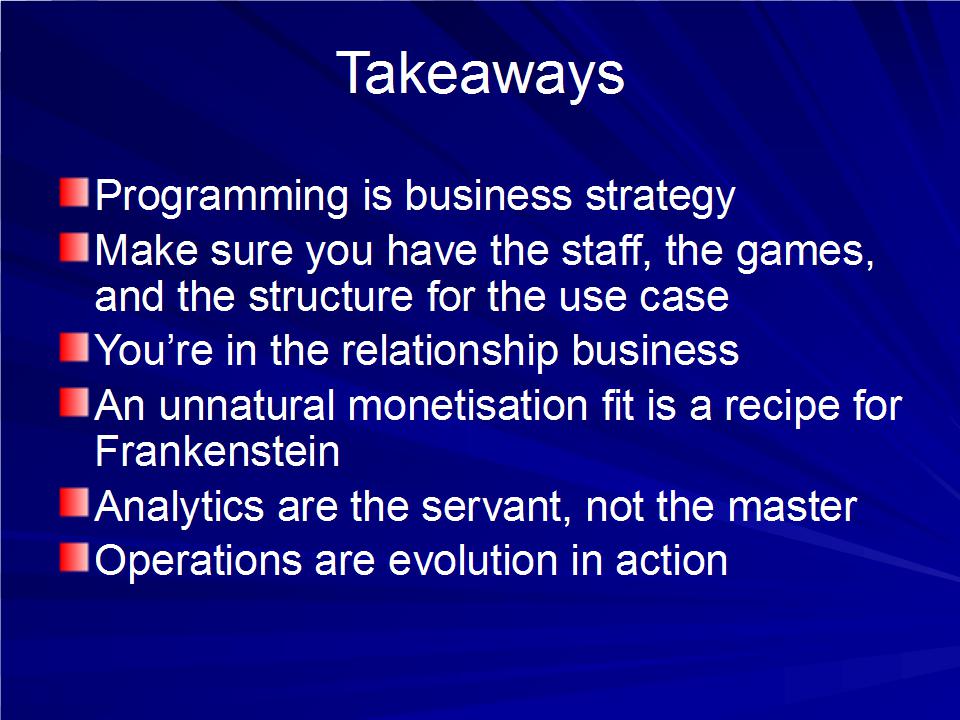The mobile game business is growing and changing rapidly, and it’s often difficult for those living inside this rapid pace to get perspective. Video games as an industry have been around for more than 30 years, and there’s a lot of valuable experience from that time that’s highly relevant today. Unlocking those vaults of knowledge and sharing some of the priceless pearls of wisdom at Casual Connect 2014 were two industry veterans, Gordon Walton and Eric Goldberg, in separate talks that addressed some important issues.
 Gordon Walton
Gordon Walton
Gordon Walton is perhaps best known for his immense labors at BioWare in bringing Star Wars: The Old Republic to life, shepherding that project through most of its lengthy development. Walton has been producing games for decades, though, and has worked with teams of a handful to teams of hundreds and back down to teams of just a few. Along the way, he’s gathered some observations about the process of moving from AAA games to mobile, and he shared those insights with the audience.
“When you’ve made big games with an army of people, can you really make games with a handful of people ” Walton asked rhetorically. “Yes, it’s like riding a bicycle.” He noted that the focus changes between small games where you’re focused on what you do today, while on big projects if you focus on daily tasks only you’ll never reach the end goal. In any case, though, you still have to make a great game regardless of the size of the project. “Quality is still #1, you can’t make games that don’t rock,” Walton said. “Every once in a while you’ll see something that breaks the rules, but usually not. You have to do less, better, rather than more, half-assed.”
“You really need to understand your market. You need to understand your customers, you need to understand how marketing is done, you need to have an idea of how you’re going to acquire those people. Developers in my experience like to ignore marketing. They like to think ‘No, no, we’ll just make a great game, all that other stuff is fluff, it’s not all that helpful.’ The truth is it’s just as important, it’s just as big a pillar as the great game. A mediocre game with great marketing doesn’t do any better than a great game with poor marketing. Both of them suffer, typically. A development leader who hasn’t studied marketing is handicapping themselves, they’re going to have to have a really great partner on that side that they trust.
Walton also discussed the importance of hiring the right people, and that on a small team everyone needs to be excellent work. As projects get bigger, you’ll need people devoted solely to management and project management, rather than everyone being hands-on. Overall, Walton noted, the drive to quality continues, and even games that are relatively simple will have a high degree of polish that goes into the graphics and game design.
 Eric Goldberg
Eric Goldberg
Next up was Eric Goldberg, a long-time game designer and executive who’s been consulting with game companies for decades. Goldberg spoke on the topic of Publishing as a Service, and how games have transformed from one-time packaged products into ongoing services. That change means re-thinking much of what goes into the design and development of games. Properly done, games-as-a-service can be terrific cash cows, propelling numerous companies into the billion-dollar annual revenue class.
Goldberg noted that there are six essential skills, which also denote areas where there are problems as we make the transition from product to service. The six essential skills: Programming (in the sense of scheduling content, not coding), deployment, direct marketing, monetization, analytics, operations. This applies to anyone who is in the service business, such as Rovio and Supercell. “They both had similar genesis stories,” Goldberg noted. “They both did 40 or 50 mobile titles that failed before they delivered their great hits. If you look at how Rovio developed Angry Birds, they did not fully get the service lessons, and Supercell — and I had the privilege of working with that team when they did their previous work at Digital Chocolate — did. In fairness to Rovio, Supercell came along two or three years later, so they had a chance to learn from their lessons.”
“There are several things that people who started in the product industry have to unlearn,” Goldberg pointed out. “One is that developers can be publishers. They could not be in the product environment, they needed the intermediaries called publishers.” The second key unlearning needed is the timing of your development effort. “Post-launch is much more important. It used to be that all of our effort went to delivering the game that shipped on that fixed date. The idea of operations, that you have to deal with an existing audience, is a key feature of services. The last is that you cannot avoid the business of games. If you are not thinking about marketing as part of your game design, you will do less well in games as a service, and in some cases, significantly less well.”
Goldberg went on to discuss the six essential skills in some detail, noting that how you schedule content and even what you call it changes significantly — while ‘sequels’ per se are rare in games as a service, there are content releases regularly that often aren’t even given a title. Deployment is the art of choosing the right platforms, territories, and partners for your game, as well as where you’re going to soft-launch it for best effect.
Direct marketing is a key discipline for games as a service, and fortunately, Goldberg points out, “There is a 150 year old discipline called direct marketing that people know how to do very well.” He recommends looking at the extensive materials on direct marketing and all the techniques that were developed for mail, because there’s great wisdom there. “The reason to do this is that most of your competitors are not doing it,” Goldberg advises.

Goldberg advises that you make monetization part and parcel of your game design — it shouldn’t be something tacked on at the end after you created the game.”We have now had several tens of thousands of games that have proved that if you do not figure out the monetization, you will fail. In fact, there’s been a whole series of well-loved games that were built for the old monetization model and failed when redone,” Goldberg said. The poster child for this, most recently, is Dungeon Keeper.
The best practice is to think about each of these six areas, and Goldberg provided his key takeaways in one slide. It’s important, too, to realize how things change as your game service scales up, and the increasing number of people you will need to devote to customer serivce.

